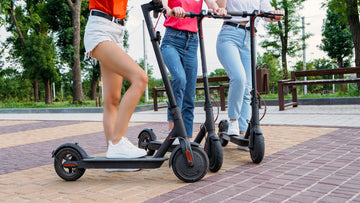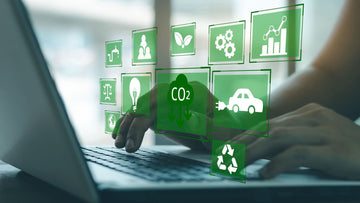The climate crisis is real and it's happening now. We've already passed the point of no return for some aspects of global warming, but there's still time to address the problem if we act now. That means each one of us needs to do our part to reduce our carbon footprint—and that includes reducing how much energy we use at home.
While it may not be easy, taking small steps towards reducing your own energy consumption can make a big difference in slowing down climate change and maybe even reversing some of its effects. So let me inspire you with this list: here are ten tips I've found helpful when trying to reduce my own carbon footprint!
Recycle
What it is: Recycling is the process of collecting waste, and turning it into a new product.
What to do: There are many different types of recycling, and you can find out what will be recycled in your area by checking with your city or county government. You can also call customer service for more information about recycling in your area.
Where to recycle: You can find places that take recyclables by looking on the internet at websites such as Earth911, or calling customer service from local waste management facilities.
Why it's important to recycle: If we don't reduce our carbon footprint by reducing waste production and reusing materials, then our future generations may not have enough resources available for them!
Keep Electronics Unplugged
Here are a few small changes you can make to start reducing your carbon footprint right away:
-
Keep electronics unplugged. When not in use, turn off your computer, TV and other electronics. It might seem like just a little thing, but it all adds up over time!
-
Use power strips. This is especially important if you have multiple devices that need to be plugged in at once (like computers or chargers). A power strip allows you to turn off the whole group of devices when all are not in use—saving energy and reducing waste from unused cords lying around the house.
-
Turn off lights when not in use (not only does this save energy but it also helps conserve precious natural resources). Do this for lamps that take 60 watts or less; these are designed for quick warmups so there’s no need for long periods of warming up before turning them on again!
Use Compact Fluorescent Lightbulbs
One of the easiest ways to reduce your carbon footprint is by switching to compact fluorescent light bulbs (CFLs). They are more energy efficient than incandescent bulbs, lasting longer and giving off a brighter light. They also cost less to operate than incandescent bulbs. CFLs come in different sizes and shapes, as well as different colors.
Use rechargeable batteries instead of disposable ones. When shopping for clothes, try to buy items that are made from natural materials such as cotton or hemp. These fabrics are biodegradable and compostable! If you can’t find any in stores, consider buying secondhand clothing at thrift shopsWhen you buy solar panels, they’re usually made from a material called silicon. The process of making this material uses a lot of energy and releases greenhouse gases that contribute to climate change. You can help reduce your carbon footprint by choosing solar panels made from other materials such as thin-film or glassThe new CFLs are brighter, more efficient and longer lasting than their older counterparts. They also come in a variety of shapes and sizes...
Install Solar Panels
If you’re looking for a way to reduce your carbon footprint, installing solar panels on the roof of your home is one of the best ways to go. Solar energy is free and abundant, so why not tap into it?
Solar panels are relatively expensive when compared with other forms of energy production (like coal and oil), but they pay for themselves over time. The upfront cost may be high, but in the long term you can end up saving quite a bit of money by using less electricity from other sources with solar panels installed in your home.
Buy Food From Local Farms
Buying food from local farms is a great way to reduce your carbon footprint. Food that is grown in the area where you live doesn't need to be transported very far, so it reduces the amount of fossil fuels needed to transport it. It also reduces the amount of packaging waste and can be more affordable than buying food from supermarkets. Local farms are also more likely to use sustainable farming practices that don't require as much energy or water (and therefore, produce less waste).
You can find many local farms by looking at nearby farmers markets or visiting an online directory like LocalHarvest.org
Stop Using Disposable Plastics
-
Avoid buying disposable plastic items.
-
Reuse your bags and containers.
-
Don't use straws, if possible.
-
Don't use disposable cutlery—bring your own! Or simply ask for a fork at restaurants that don't provide it automatically with every meal; it's really not much of an inconvenience for them or for you.
-
Buy reusable water bottles instead of single-use plastic bottles.
CFLs produce less heat than incandescent bulbs. This means they are safer to use near flammable materials such as curtains or drapes. They also don’t emit UV rays, which make them ideal for use in enclosed spaces such as aquariums.
Eat Sustainable Seafood
-
Avoid seafood that is overfished.
-
Avoid seafood caught in ways that harm other marine life.
-
Avoid seafood treated with antibiotics or hormones.
-
Avoid seafood fed food pellets made from fish (e.g., Atlantic salmon, Tilapia).
-
Be careful about where you buy your fish—the environmental standards of the country where it was harvested could differ greatly from those of your home country.
Solar panels are made up of many individual cells that can convert sunlight into electricity. When the sun hits these cells, it creates a flow of electrons through wires inside them. The electrons are then converted into usable electricity for your home or business.
Drive Less and Go Electric
-
Reduce your driving. Whether it’s a matter of going for a run or taking public transport, you can make a big difference by reducing the number of miles you drive.
-
Go electric. If your car is still gas-powered, consider switching to an electric vehicle (EV). EVs are powered either by electricity or battery and have no tailpipe emissions—meaning they produce zero carbon dioxide thanks to their clean-energy source. While EVs may cost more up front than conventional vehicles, many offer rebates and tax credits that help offset the additional expense over time; other incentives include free charging at government facilities or access to high-occupancy vehicle lanes on highways and toll roads where there's heavy traffic congestion at certain times during the day (e.g., rush hour). And while some states require EV owners to pay higher registration fees than their non-electric counterparts due largely in part due ____ insert here: "because they don't contribute."
Use Reusable Bags, Containers, and Bottles
Reusable bags are better for the environment than single-use plastic bags.
Reusable bags can also save you money over time. If you think about how much money you spend on single-use plastic bags each year, and then realize that reusable materials like canvas totes will last longer than a year, you might find that they actually save you money in the long run.
Of course, if you have reusable containers at home already (like those cute Tupperware containers), then this tip won't be as useful to you! However, if not many people in your household use them regularly, it's worth looking into getting some new sets so that everyone starts using them whenever possible.
Switch to a Vegetarian Diet or a Flexitarian Diet
Switching to a vegetarian diet or a flexitarian diet can help reduce your carbon footprint. Vegetarian diets are based on foods that come from plants like fruits, vegetables, grains, nuts and seeds. Flexitarian diets include meat but only occasionally.
Here are some benefits of going vegetarian or flexitarian:
-
Healthier for you – studies have shown that vegetarians tend to live longer than meat eaters and have lower rates of heart disease, cancer and diabetes.
-
Healthy for the planet – animal agriculture causes more greenhouse gas emissions than the entire global transportation sector combined! Reducing animal products in your diet will make a big impact on reducing your carbon footprint!
-
More delicious food options – eating less meat means more room in your budget for delicious plant-based foods like vegan cheese or tofu! You'll also find lots of amazing recipes online if you want something new to try!
How do I go about making this change? Here's how:
This list should inspire you to make changes around your home and in your life to reduce your carbon footprint.
You can reduce your carbon footprint by making small changes around your home. Some of these changes will cost you money, but others won’t require any investment at all.
You should care about reducing your carbon footprint because it helps keep the environment safe from harm caused by climate change.
Your carbon footprint is a measure of how much greenhouse gas (GHG) each person releases into the atmosphere.
The average American has an annual GHG emissions of 17 tons per person per year (t/yr). The average European has 10 t/yr and the average Chinese has 7 t/yr.
Conclusion
We hope this list has inspired you to make changes around your home and in your life to reduce your carbon footprint. We know that it can seem overwhelming, but starting with small steps is often the best way to accomplish big goals. For example, if you don’t have access to solar panels or renewable electricity yet, try unplugging electronics when not in use (like turning off lights when leaving rooms). If you don’t have access to reusable bags at all times yet, try carrying one with you every day for errands around town so that you get used to having them on hand! And even if it doesn’t seem like there are many good options for sustainable seafood near where we live now (or at least none we've found), we still recommend reducing consumption of fish from overfished areas whenever possible because it helps protect ocean ecosystems from further damage








